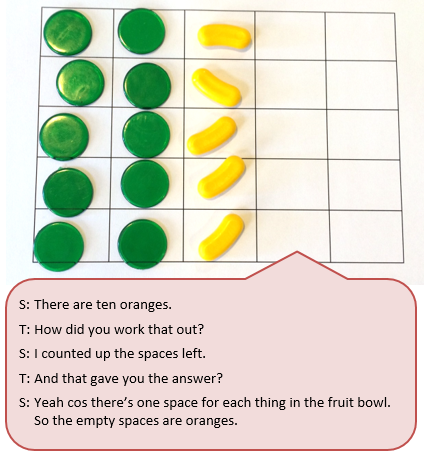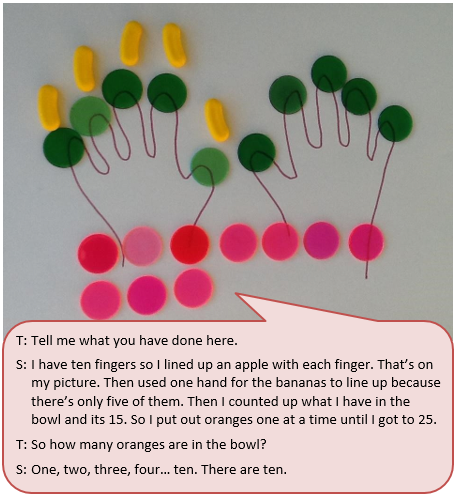The purpose of this activity is to engage students in problem solving to find an unknown addend.
This activity assumes the students have experience in the following areas:
- Counting on and back from any number in ones.
- Ordering whole numbers, including putting numbers of a number line.
- Using materials to represent number problems.
- Adding and subtracting simple whole numbers using counting and part-whole strategies.
The problem is sufficiently open ended to allow the students freedom of choice in their approach. It may be scaffolded with guidance that leads to a solution, and/or the students might be given the opportunity to solve the problem independently.
The example responses at the end of the resource give an indication of the kind of response to expect from students who approach the problem in particular ways.

A class of 25 students are sharing a basket of fruit. There is exactly one piece of fruit for each student.
In the basket are:
- 10 green apples
- 5 bananas
- Some oranges
How many oranges are in the basket?
The following prompts illustrate how this activity can be structured around the phases of the Mathematics Investigation Cycle.
Make sense
Introduce the problem. Allow ākonga time to read it and discuss in pairs or small groups.
- What do you think the problem is about?
- What information has been given?
- What will an answer to the problem look like?
- What do you need to find out?
Plan approach
Discuss ideas about how to solve the problem. Emphasise that for now you want ākonga to say how they would solve the problem, not to actually solve it.
- What might be useful ways to solve this problem?
- What tools might be useful, such as a number line, counters, and fingers?
- How could I use others to help me solve the problem?
- Could I act the problem out? Could I draw a diagram?
- How might I record to organise the information?
Take action
Allow ākonga time to work through their strategy and find a solution to the problem.
- Am I recording in an organised way so I can keep track of the fruits?
- Is my working correct? How can I check? How can I make sure I did not miss any numbers in my counting?
- Do I see any pattern? How might what I know about fives help me?
Convince yourself and others
Allow ākonga time to check their answers and then either have them pair share with other groups or ask for volunteers to share their solution with the class.
- Have I got an answer? Does my answer seem right? How can I check?
- How can I convince others that I am right?
- What ways can I find to show other people I am right?
- Did I use a good strategy? How does my strategy compare with what others did?
- Would this help me solve a similar problem? How?
Examples of work
Work sample 1
The student is provided with a 5 x 5 grid and uses physical objects to represent the different fruit. They count the missing spaces to find the unknown number.
Click on the image to enlarge it. Click again to close.
Work sample 2
The student creates a physical model to represent the number of fruits and counts on the find the missing number of oranges.

